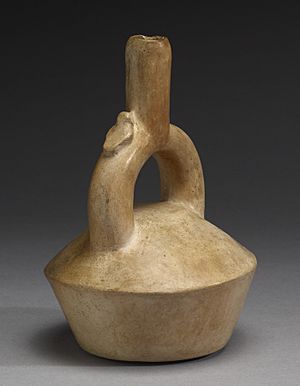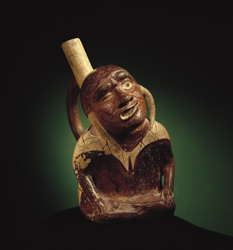Stirrup spout vessel facts for kids

A stirrup spout vessel is a special kind of ceramic pot. It gets its name because its handle looks like a stirrup, which is part of a horse's saddle. These unique pots were very common among ancient cultures in South America. They started appearing around 2000 BCE.
Some of the cultures that made these vessels include the Chavin and the Moche. On these pots, the stirrup handle is actually part of the spout where liquids pour out. The main part of the pot was often shaped using a mold. But the stirrup spout itself was carefully made by hand. It was then attached to the pot using a special clay mixture called slip.
Contents
Moche Culture and Stirrup Spout Vessels
The Moche (say: moh-chay) culture was a powerful group of people. They lived in the river valleys along the North Coast of Peru. This culture began to grow and thrive around 100 CE. For almost 600 years, the Moche people expanded across the dry coastal plains of Peru.
The Moche were skilled builders. They created huge temples and large systems of irrigation canals. They also made a lot of amazing artwork and pottery. Moche art tells us a lot about their daily lives. It shows important people, plants, and even their gods. The art also shows activities like hunting, fishing, and special ceremonies.
Archaeologists have found many Moche artworks. Most of these are Moche ceramic pots, which have lasted a long time. The Moche were especially good at making stirrup spout vessels. They used these for beautiful art pieces. They also sculpted them into detailed forms, like Moche portrait vessels of their leaders.
Stirrup spout vessels were made in many shapes. They could be round, square, or angled. The Moche made thousands of these vessels. They used them for both everyday tasks and as works of art.
There were two main types of stirrup spout vessels made by the Moche. One type was created using a three-dimensional mold. This allowed them to form the clay into detailed images or figures. A very popular Moche style was the "portrait vessel." These pots were very detailed. They usually showed the heads of adult men. Because they were so detailed, many people believe these were real portraits. They likely showed important Moche leaders.

The second type of Moche ceramic art was called Fineline painting. This was detailed painting on pottery. This art style gives us a lot of information about Moche life and beliefs. It shows us their daily routines, their myths, and their special rituals. Researchers Christopher B. Donnan and Donna McClelland have grouped these paintings into five categories. These include Vessel Forms, Daily Life, the Natural World, the Supernatural, and Narrative Themes.
Water in Moche Ceramics
The Moche lived in an area with big changes in weather. They had very dry summers and rainy winters. Sometimes, events like El Niño would cause problems. This could mean very long droughts or terrible floods. Because of this, managing water was very important for the Moche. It helped them survive and grow.
The Moche were wealthy because of their farming. They grew crops like corn and beans. This was possible because they built a huge system of irrigation canals. These canals brought water from rivers to their towns and farms. Having a steady water source was key for the Moche to develop their society.
The Moche's focus on water also shows up in their pottery. The design of the stirrup spout itself might be linked to water. When you tip the pot to pour water out, or when you fill it, the circular stirrup spout lets water flow smoothly. This design might reflect how important water control was to them.
Moche Ceramic Fineline Painting
The Moche people did not leave behind a written language. However, their art, especially their pottery, helps us understand their culture. Fineline paintings on stirrup spout vessels are very important. They allow archaeologists to learn about Moche daily life, their myths, and their stories.
To understand these paintings, scholars often make "rollouts." This means they photograph the painting as if it were unrolled from the pot. Christopher B. Donnan and Donna McClelland have done a lot of work on this. These rollouts make it easier to see the full story or narrative shown on the vessel.
Many important themes have been found in Moche art. The paintings on stirrup spout vessels show many activities. These include how the Moche ate, how they wove cloth, their warfare, and their hunting. They also show their clothing and jewelry.
One famous example is the "Presentation Theme." This scene shows several figures taking part in an important ceremony. In the bottom part of the scene, some captured people are shown. In the scene above, several richly dressed figures are passing around a special cup.
There has been some discussion about who these ornate figures are. Are they gods, or are they high-ranking Moche officials dressed in special costumes? This question became more interesting after a discovery at the Moche site of Sipán. Archaeologists found the remains of a Moche leader there. He was buried wearing a costume similar to a "Rayed Deity" seen in the Presentation Theme.
This discovery changed how many archaeologists thought about Moche art. Some still believe the art shows deities. They think the "Lord of Sipán" was dressed like a god to honor him. Others believe the scene shows real historical events. They think it is a record of Moche history, not just myths.
This theme, like others, tells a clear story. Even without written records, the art on stirrup spout vessels helps us understand Moche beliefs and practices. By studying these images, scholars learn about Moche activities like warfare and special ceremonies. The figures in the Presentation Theme also appear in other Moche art. Other identified themes include the Burial Theme, The Revolt of the Objects, the Tule Boat Theme, and the Runner Theme.
See also
 In Spanish: Botella de pico de estribo para niños
In Spanish: Botella de pico de estribo para niños

